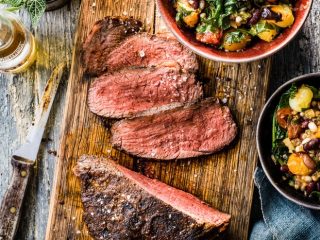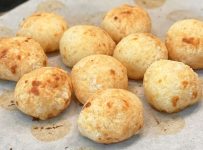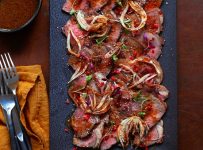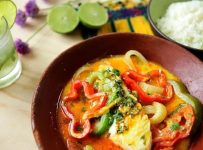Brazilian Moqueca is a delicious and flavorful seafood stew that originates from Brazil’s coastal regions, particularly Bahia and Espírito Santo. This dish is a harmonious blend of Afro-Brazilian and Portuguese culinary influences, making it a vibrant representation of Brazil’s rich cultural heritage.
Origins and Cultural Significance
Moqueca is more than just a dish; it’s a culinary tradition that has been passed down through generations. The name “Moqueca” comes from the indigenous Tupi-Guarani language, where “moquém” refers to the technique of slow-cooking food wrapped in leaves or in clay pots over an open flame. Over time, this method evolved, and the dish became popular in Brazil’s coastal regions, particularly among Afro-Brazilian communities.
In Bahia, Moqueca is typically made with coconut milk, palm oil (known as dendê oil), and a mixture of seafood such as fish, shrimp, and sometimes crab. The Bahian version is rich and creamy, with the palm oil giving it a distinctive orange hue and a slightly nutty flavor. In contrast, the Moqueca Capixaba from Espírito Santo is lighter and often made without coconut milk or palm oil, instead using olive oil and a more tomato-based broth. Both versions, however, share the same base ingredients of fresh seafood, tomatoes, onions, garlic, and cilantro.
Ingredients and Preparation
Making Moqueca is relatively simple, but the key lies in the freshness of the ingredients and the balance of flavors. Here’s a general overview of how to prepare Brazilian Moqueca:
Ingredients:
- Seafood: A variety of seafood can be used, including white fish like cod or snapper, shrimp, and even squid. The choice of seafood often depends on what is locally available and fresh.
- Vegetables: Tomatoes, bell peppers, onions, and garlic are essential for the stew. These vegetables are typically sliced and layered in the pot.
- Coconut Milk: This adds creaminess and richness to the dish, particularly in the Bahian version.
- Palm Oil: Used in the Bahian version, palm oil gives the dish its characteristic color and depth of flavor.
- Cilantro and Lime: These are crucial for the finishing touch, adding freshness and acidity that balance the rich stew.
Preparation:
- Marinate the Seafood: The seafood is usually marinated with lime juice, garlic, salt, and pepper for about 30 minutes. This helps infuse the seafood with flavor.
- Layer the Ingredients: In a large pot or clay dish, layer the sliced onions, bell peppers, and tomatoes. Add the marinated seafood on top, and then pour over the coconut milk and palm oil.
- Cook Slowly: The dish is cooked over medium heat until the seafood is tender and the vegetables have softened. The stew should not be stirred too much to keep the fish intact.
- Finish with Cilantro and Lime: Before serving, the stew is garnished with fresh cilantro and a squeeze of lime juice, which brightens the dish and adds a final layer of flavor.
Serving and Accompaniments
Moqueca is traditionally served with rice, which soaks up the flavorful broth. In Bahia, it’s often accompanied by farofa (toasted cassava flour) and pirão, a thickened sauce made by mixing the Moqueca broth with cassava flour. These sides add texture and a subtle nutty flavor that complements the stew.

Nutritional Value
Moqueca is a nutritious dish, offering a good balance of protein from the seafood, healthy fats from the coconut milk and palm oil, and a variety of vitamins and minerals from the vegetables. The dish is relatively low in carbohydrates, making it suitable for those following a low-carb diet. The use of fresh ingredients and the absence of processed foods also makes it a healthier option compared to many other stews and curries.
Conclusion
Brazilian Moqueca is a vibrant, flavorful stew that embodies the rich cultural heritage of Brazil. Whether you’re enjoying the creamy Bahian version or the lighter Moqueca Capixaba, this dish offers a delicious blend of flavors and textures that are sure to delight your taste buds. The combination of fresh seafood, vegetables, and the unique flavors of coconut milk and palm oil makes Moqueca a must-try dish for anyone interested in exploring the diverse cuisine of Brazil.
For those looking to make this dish at home, it’s important to use the freshest ingredients possible and to take your time with the preparation. The result will be a delicious, hearty stew that’s perfect for sharing with family and friends. Whether served with rice, farofa, or just enjoyed on its own, Brazilian Moqueca is a dish that brings the flavors of Brazil’s coastal regions to your table.




